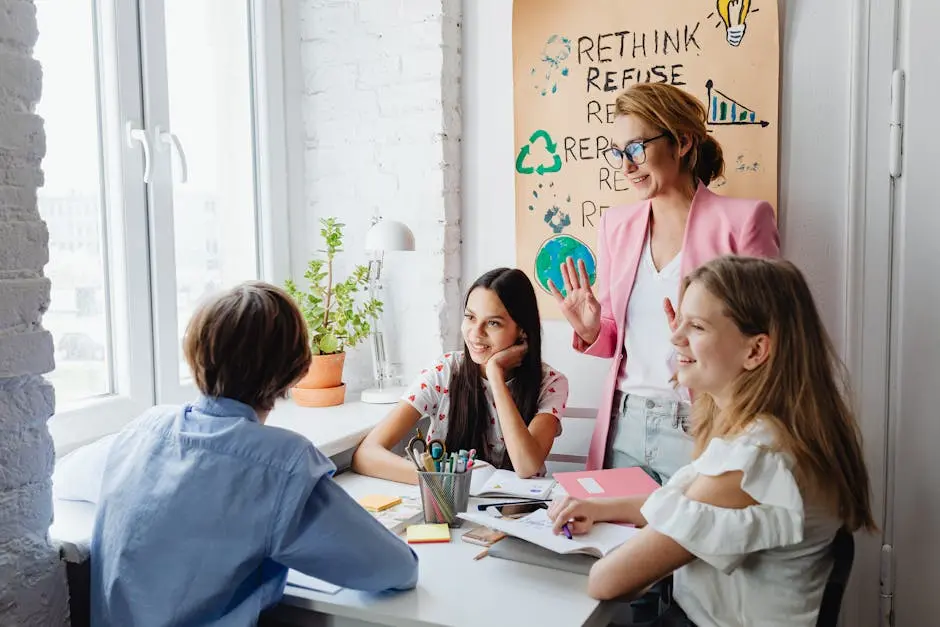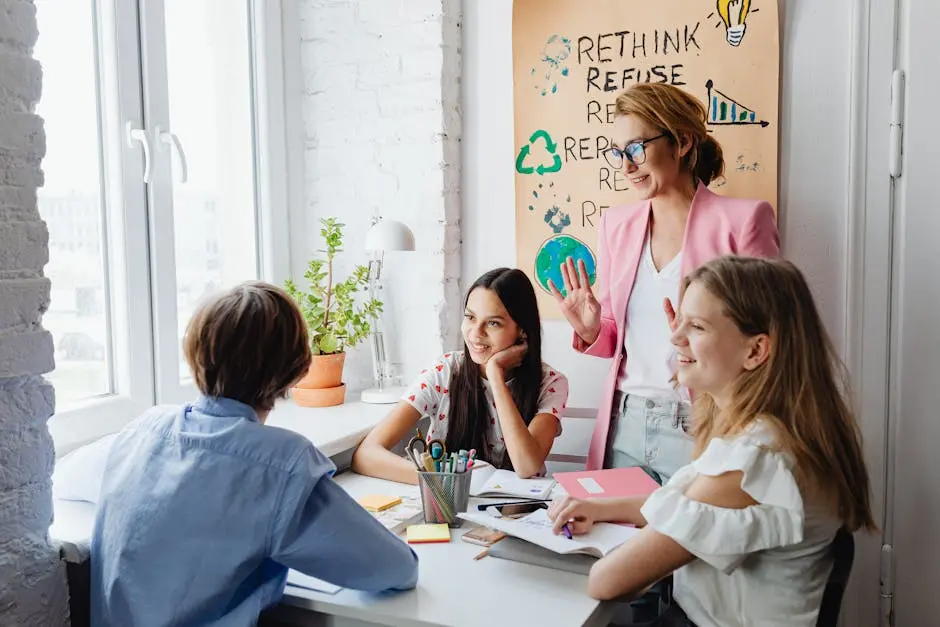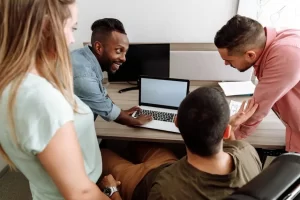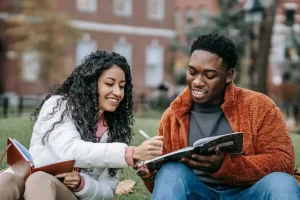Engaging students in the classroom requires creativity and adaptability. This blog post will explore innovative lesson planning ideas that will transform your classroom into an interactive hub of learning. Whether you’re a seasoned educator or just starting your teaching journey, these strategies will help you keep your students involved and excited about learning.
Understanding the Importance of Interactive Learning
Interactive learning encourages participation and collaboration among students. In this section, we’ll discuss the importance of fostering an environment where students feel involved and empowered in their learning.
When students engage actively, they retain information better. This phenomenon occurs because active participation stimulates mental processes. Rather than passively receiving information from a teacher, students who interact with their peers or with learning materials are more likely to remember what they’ve learned. A study emphasizing this shows that students involved in group discussions tend to outperform those who study alone.
Furthermore, interactive learning nurtures critical thinking skills. By discussing ideas, posing questions, and providing feedback, students learn to approach problems from multiple perspectives. They begin to analyze and synthesize information, ultimately leading to a deeper understanding of the material. It’s important for educators to design lessons that prioritize not just the transfer of knowledge, but the exploration of concepts through collaboration.
Incorporating Technology in Your Lesson Plans
Technology can be a powerful tool for creating interactive lesson plans. Let’s explore various tech tools and apps that can enhance student engagement and facilitate collaborative projects.
Imagine a classroom where every student has a tablet or laptop at their fingertips. This level of access opens doors to collaborative tools like Google Classroom or Padlet, allowing students to work together seamlessly. They can brainstorm ideas, contribute to shared documents, and give real-time feedback. This modern approach makes learning dynamic and accessible, breaking the traditional confines of the classroom.
In addition, educational platforms like Kahoot! or Quizizz can gamify the learning experience. They allow educators to create quizzes and fun challenges, turning assessments into engaging competitions. Students love the thrill of responding to questions in real-time, which not only reinforces their knowledge but also cultivates a sense of community as they cheer for each other’s successes. By merging technology with learning, you create a vibrant classroom atmosphere.
Moreover, incorporating multimedia presentations makes lessons come alive. Tools like Prezi or Canva can help students visualize complex concepts through stunning graphics and formats. When students are given the opportunity to express their ideas in a visually appealing way, their confidence and understanding often soar. The use of technology in lesson planning is not merely a trend; it’s a transformative practice that enriches the whole educational experience.
Hands-On Activities That Promote Engagement
Engaging students with hands-on activities can make learning memorable. In this section, we’ll discuss some creative activities that cater to different learning styles and encourage active participation.
One delightful approach is to incorporate project-based learning, where students tackle real-world problems. Picture your students designing a sustainable garden as part of their science curriculum. Through this activity, they don’t just learn about ecosystems; they also collaborate, plan, and execute a project that has tangible results. This experience can lead to discussions on environmental responsibility, nutrition, and even math skills when measuring space and calculating costs.
Using role-play is another effective technique to deepen understanding. For instance, if you’re teaching historical events, let students assume the roles of historical figures and reenact key moments. This method not only makes history feel alive but also invites empathy and perspective-taking—skills crucial for personal and social development. Students will not only recall facts but also understand the motivations and emotions behind them.
Lastly, consider incorporating art into your lesson planning. Whether through drawing, painting, or building models, encouraging students to express their understanding artistically can cater to learners who thrive in creative environments. Imagine exploring literary characters through dramatic performances or using visual art to capture scientific concepts; these methods breathe life into lessons and promote diverse ways of knowing.
Using Gamification to Inspire Learning
Gamification is a great way to turn lesson planning into an exciting challenge. We’ll look at how to incorporate game mechanics into your lessons to motivate students and enhance their learning experience.
Think about integrating points systems, badges, or even leaderboards in your classroom. When students are rewarded for accomplishments, be it completing a task or mastering a concept, the intrinsic motivation to excel often skyrockets. It’s incredible to see students working collaboratively to earn a badge that signifies mastery in a subject, reinforcing not only knowledge but also a sense of ownership over their learning.
Moreover, crafting story-based learning experiences can transform mundane topics into epic quests. By setting up a narrative framework where students embark on a journey to solve problems or complete missions, you’re creating an engaging context for learning. This approach not only captivates attention but also helps students relate personally to the material, as they see themselves as active participants in a larger story.
Additionally, using platforms designed for gamified learning like Classcraft can enhance teamwork among students. Groups become ‘adventurers,’ working together to overcome challenges and share their knowledge. This collaborative dynamic helps foster a positive classroom community and results in deeper learning, showing students that education can indeed be a fun and thrilling quest.
Creating Collaborative Projects and Group Work
Group projects can foster teamwork and improve communication skills. This section will provide creative ideas for collaborative projects that promote interaction and help students learn from one another.
Consider launching a semester-long project where each group investigates a different social issue. Through research, presentations, and discussions, students not only learn about the topic at hand but also develop vital skills in collaboration, critical thinking, and public speaking. They must listen to one another, merge diverse ideas, and arrive at consensus, which simulates real-world teamwork.
Moreover, establishing peer teaching opportunities can be deeply rewarding. Assign students the responsibility to teach their peers about a specific topic they’ve mastered. This practice not only consolidates their own learning but also builds confidence in presenting and articulating ideas clearly. When a student explains a concept to their peers, it reinforces their understanding and fosters a supportive environment, where every student feels valued as a contributor.
Finally, don’t underestimate the creative potential of fostering partnerships with local community organizations. Students can engage in service-learning projects that allow them to address real community needs. By collaborating with local experts, students learn to apply their academic skills to real-world situations while making meaningful connections, widening their perspectives and helping them see the importance of their education beyond the classroom.
Feedback and Reflection: Key Elements of Interactive Lessons
Feedback and reflection are essential for continuous improvement. We’ll explore ways to integrate reflective practices into your lesson plans to encourage students to think critically about their learning.
When structuring lessons, integrating regular feedback loops can significantly enhance learning outcomes. For example, after a group project, conduct a debriefing session where each student shares what they learned, what challenges they faced, and how they overcame them. This practice not only fosters open communication but also provides insights into the learning process itself.
Encouraging self-assessment is another valuable technique. Give students tools to evaluate their own understanding and progress. Reflection journals are a fantastic way to promote this practice, allowing students to jot down their thoughts on each lesson or project, detailing what they learned or what they wish to explore further. This reflection aids in personalizing their learning journey and deepening their engagement.
Lastly, consider implementing peer feedback sessions. When students provide constructive feedback to each other, it builds a collaborative learning environment while promoting critical skills. They become accustomed to giving and receiving constructive criticism, which is invaluable in both academic and future career settings. This emphasis on reflection ensures that students are not merely passive recipients of knowledge but active participants in a journey of continuous growth.
Final Thoughts on Interactive Learning
By incorporating these creative lesson planning ideas into your teaching, you can foster a stimulating and interactive classroom environment. Remember, the goal is not only to deliver content but to engage students in their learning journey. Explore these strategies, adapt them to your unique classroom needs, and watch your students thrive.








